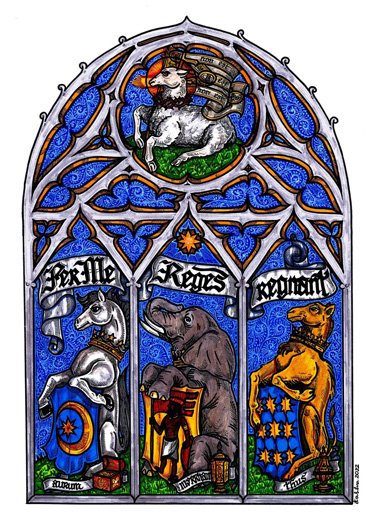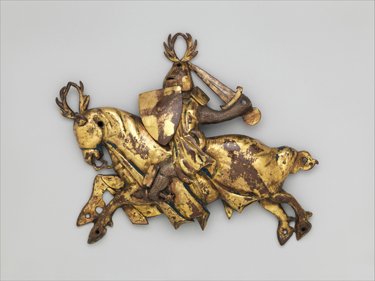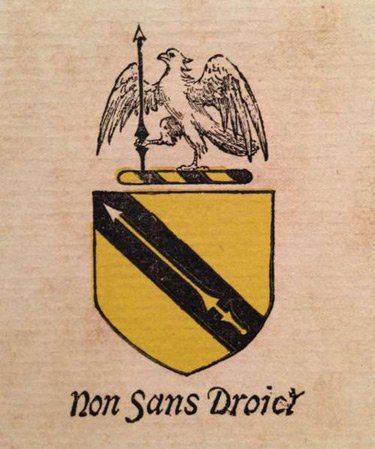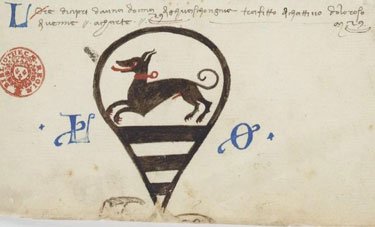“Arms attributed to the Magi”, The Heraldic King’s Beasts, 2022.
“Tuitio Fidei et Obsequium Pauperum (Defence of the Faith and Assistance to the Poor)
Heraldry, Sovereign Military Hospitaller Order of Saint John of Jerusalem of Rhodes and of Malta
How to Address a Letter to One of Her Majesty’s Heralds
British Postal Service, College of Arms, Great Britain, Heraldry
A British wag, who is himself an armiger and an enthusiast of Heraldry, found himself with occasion to write to one of the United Kingdom’s Officers of Arms, so he decided to address his envelope as above.
Translation:
Robert Noel, Lancaster Herald
• HM College of Arms
• City of London
I think there was probably a decent chance that someone in the British postal service would figure it out.
Made by Cartier for Princess Grace
Cartier, Grimaldi Family, Heraldry, Jewelry, Monaco, Princess Grace
A brooch depicting the Grimaldi arms, which being the arms of a Prince are displayed beneath a mitre crown on a mantle of ermine, Fusily (or lozengy) argent and gules. The supporters (two monks wielding swords) refer to the conquest of Monaco in 1297, when François Grimaldi entered the city with soldiers dressed as monks, with swords hidden under their cassocks. The collar surrounding the shield is the Order of St. Charles, a Monaguesque order founded in 1858. The Grimaldi motto is Deo Juvante “With God’s help”.
Shakespeare’s Coat of Arms
Folger Library, Heather Wolfe, Heraldry, William Shakespeare
The Guardian can’t resist throwing in a snide attack on “Trump’s America” in the opening of a report on the discovery of a significant new piece of data from the life of Shakespeare, one confirming the poet’s worldly success and resulting rise to gentility.
Dr [Heather] Wolfe is a willowy, bright-eyed manuscript scholar, a paleographer specialising in Elizabethan England who in certain moods of candour might put you in mind of Portia or perhaps Cordelia. She’s also a Shakespeare detective who, last year, made the career-defining discovery that is going to transform our understanding of Shakespeare’s biography. In the simplest terms, Wolfe delivered the coup de grace to the wild-eyed army of conspiracy theorists, including Vanessa Redgrave and Derek Jacobi, who contest the authenticity, even the existence, of the playwright known to contemporaries as Master Will Shakespeare. …
Wolfe’s role as a curator at the Folger is to bring her expertise to bear on the tantalising mass of documents that survives from the late 16th century. And yet, despite a heap of legal, commercial and matrimonial evidence, Shakespeare the man continues to slip through scholars’ fingers. Four centuries after his death, apart from a handful of crabbed signatures, there is not one manuscript, letter or diary we can definitively attribute to the poet, sponsoring the pervasive air of mystery that surrounds his genius. Indeed, the most intimate surviving Shakespeare document remains that notorious will, in which he bequeathed his wife his “second best bedâ€.
Before Wolfe arrived on the scene, all that scholars could be certain about was that a man named Shaxpere, Shaxberd or Shakespear was born in Stratford in 1564, and that he was an actor whose name is printed in the collected edition of his work published in 1623. We also know that he married Anne Hathaway, and died in 1616, according to legend, on his birthday, St George’s Day. The so-called “Stratfordian†case for Shakespeare rested on these, and a few other facts, but basically, that was it. …
Wolfe’s appetite for manuscript corroboration has led her into many dusty corners of the Elizabethan archives. It was this research instinct that first led her to reopen the file on the coat of arms granted to Shakespeare’s father, the small-town glover, in 1596.
John Shakespeare, from Stratford-upon-Avon, was ambitious to rise in the world. He was certainly not the first Englishman keen to put his origins as a provincial tradesman behind him. Among his contemporaries in Stratford, he was a figure of fun for his social climbing. English class snobbery has a long pedigree. His son, who would continue the quest for official recognition after his father’s death, also attracted metropolitan disdain as “an upstart crow beautified with our feathersâ€. In 1601, after his father’s death, Shakespeare the upstart returned to the college of arms to renew the family application for a coat of arms. He had made a small fortune in the theatre, and was buying property in and around Stratford. Now he set out to consolidate his reputation as a “Gentlemanâ€. Under the rules that governed life at the court of Elizabeth I, only the Queen’s heralds could grant this wish.
A much-reproduced sketch for a coat of arms crystallised Shakespeare’s hopes for legitimacy in the antique jargon of heraldry: “On [Sic: should be “Or a Bend Sable”] a Bend Sables, a Speare of the first steeled argent. And for his Crest, a falcon, his winges displayed Argent, supporting a Speare Gould …†The needy applicant also attached a motto: Non Sanz Droit (“Not Without Rightâ€). All this, and much more, is buried in the archives of the college of arms in London. …
An adjunct to the court, the College of Heralds was not exempt from its own secret feuds. In 1602, the internecine rivalry between Sir William Dethick, the Garter King of Arms, and another herald, Ralph Brooke, burst into the open when Brooke released a list of 23 “mean persons†whose applications for crests (he claimed) had been wrongfully preferred by Dethick. When “Shakespeare the Player†found himself on this list, his campaign for social advancement seemed in jeopardy. A bitter row broke out at court between two factions. Shakespeare himself became an object of ridicule. Another rival, Ben Jonson, in his satire Every Man out of his Humour, poked fun at him as a rustic buffoon who pays £30 for a ridiculous coat of arms with the humiliating motto “Not Without Mustardâ€.
It’s at this point in the story that Wolfe discovered “the smoking gunâ€. In the Brooke-Dethick feud, it becomes clear that “Shakespeare, Gent. from Stratford†and “Shakespeare the Player†are the same man. In other words, “the man from Stratford†is indeed the playwright. Crucially, in the long-running “authorship†debate, this has been a fiercely contested point. But Wolfe’s research nails any lingering ambiguity in which the Shakespeare deniers can take refuge.
Complete story.
Hat tip to Karen L. Myers.
Yale Names New Residential College “Heads” and Reveals New Heraldry
Heraldry, Residential Colleges, Time and Change, Yale
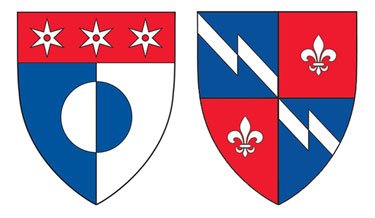
Somebody-You-Never-Heard-of College (left) and Benjamin Franklin College (right).
The inaugural heads of Yale’s two new residential colleges have been announced by President Peter Salovey and Yale College Dean Jonathan Holloway. Charles Bailyn, professor of astronomy and physics, will be the head of Benjamin Franklin College, and Tina Lu, professor of East Asian languages and literatures, will be the head of Pauli Murray College.
The new colleges will be finished by the time the incoming Class of 2021 arrives on campus. …
Bailyn has been a member of the Yale community since his undergraduate years, earning his B.S. in astronomy and physics from Yale College in 1981 [ Calhoun – JDZ ] and later returning to campus in 1990 to join the faculty ranks. In 2010 he was named the A. Bartlett Giamatti Professor of Astronomy and Physics. From 2011 to 2016 he served as the inaugural dean of the faculty of Yale-NUS College in Singapore.
In his research, Bailyn studies black holes and related sources of celestial X-rays, as well as dense star clusters and the effects of collisions between stars. His work on measuring the masses of black holes was awarded the 2009 Bruno Rossi Prize from the American Astronomical Society, and he has carried out research with a wide variety of ground- and space-based telescopes, including NASA’s Hubble Space Telescope. …
As a Yale undergraduate, Bailyn was awarded the George Beckwith Prize in astronomy and was an avid participant in the a cappella singing scene. Salovey and Halloway noted in their letter that Bailyn considers becoming a pitchpipe of the Duke’s Men at the age of 19 one of the highlights of his undergraduate experience. After completing his Yale College degree, he pursued graduate work at the University of Cambridge and at Harvard University, receiving his Ph.D. from Harvard in 1987 and spending three years as a member of Harvard’s Society of Fellows before returning to Yale as an assistant professor of astronomy. He has served both as chair and as director of undergraduate studies in the Department of Astronomy and was a member of the 2001-03 Committee on Yale College Education, which reviewed Yale’s undergraduate curriculum. He twice chaired the Teaching, Learning, and Advising Committee in Yale College. In his five years at Yale-NUS, he led the recruitment of more than 100 faculty members and supervised the development of the college’s common curriculum.
———————
Tina Lu joined Yale’s Department of East Asian Languages and Literatures (EALL) in 2008, with a secondary appointment in the Department of Comparative Literature. She has served as EALL’s director of graduate studies (from 2009-2010), director of undergraduate studies (2012-2013), and chair (2013-present). In 2009 she was a visiting professor with the Yale-PKU program in Beijing; since 2013 she has been a consulting faculty member to Yale-NUS College, where she taught as a visiting professor in spring 2015.
Specializing in Chinese literature from 1550 to 1750, Professor Lu has written three books — one on personal identity, one on the nature of the human community, and the most recent (still being completed) about materiality. Noted Salovey and Holloway: “In the course of them, she has discussed a portrait that comes to life, optical illusions, and stories about severed heads!†Her current work examines time travel and its pre-modern antecedents. With colleagues at other universities in art history and social history, she is also at work on a collaborative book about Xu Wei, the 16th-century polymath, playwright, and painter.
One of her major ongoing projects is The Ten Thousand Rooms, a web-based platform she is developing with grant support from the Mellon Foundation (and in collaboration with her colleague Mick Hunter) that will allow scholars around the world to work together on the transcription, translation, and commentary of pre-modern Chinese sources. She has been an invited speaker and panelist at dozens of universities and other forums in the United States and internationally. In 2009, she was awarded the Gustav Ranis Prize for Best Book on an International Subject by a Yale Faculty Member, and from 2005 to 2011 she was a Mellon Foundation New Directions Fellow. She has served on numerous Yale advisory groups, from the Humanities Program Executive Committee to the Digital Humanities Executive Committee to the Yale-NUS Advisory Committee and Curriculum Review Committee. Her undergraduate courses include EALL 200, “The Chinese Tradition,†an overview of Chinese culture and history from antiquity to the 20th century.
Lu earned her A.B. (in East Asian languages and civilizations) and Ph.D. (in comparative literature) from Harvard University. Prior to coming to Yale, she was a member of the faculty at the University of Pennsylvania from 1998 to 2008, earning tenure in 2004.
Yale’s residential college “heads” seem to be younger these days, not as distinguished as they used to be, and more commonly chosen on the basis of “diversity” (what some of us would call: favoritism), but Professor Bailyn looks to me like a decent choice. At least he’s a Yalie.
Professor Lu, appropriately for her new college, is diverse. But, at least, she has eccentric areas of academic study, so I suppose they could do worse.
What is up, however, with these new college coats of arms?
College and universities customarily assume the arms of their namesake. Benjamin Franklin had a real coat of arms, complete with dolphins no less. Why on earth aren’t they using it?
Whatever-her-name-was, doubtless, had no coat of arms, so Yale is free, I suppose, to invent one and confer it on her, but Yale ought to be aware that these are referred to coats of arms or armorial achievements, not “shields.” And unmarried ladies’ arms are displayed on a lozenge (a diamond) or an oval, and not upon a shield.
Yale can’t even do heraldry right today. Sigh.

Benjamin Franklin’s real coat of arms, blazoned: Argent on a bend between two lions’ heads erased gules, a dolphin embowed of the first between two martlets or.
Greyhound Coat of Arms
Bibliotheque National Francaise, Books, Coursing, Heraldry, The Decameron
Architectural Whimsy and a Coincidence
Architecture, Austria, Genealogy, Heraldry, History
My wife Karen forwarded to me the other day Gizmodo’s story on a dry nook in the middle of a pond in Vöcklabruck, Austria, and it is certainly an eye-catching and amusing architectural gimmick.
The interesting coincidence is the location.
Vöcklabruck, in Upper Austria is my family’s ancestral home.
They were first recorded under the surname “Buchhaim,” which later became corrupted into Puchhaim and finally Pöchner. (Zienkiewicz came later.)
Seibmacher writes:
Über die Heimat der Pöchner ist nichts verlässliches bekannt. Während einige dieselben aus Schottland stammen lassen, wieder andere Steiermark als ihre Heimat nennen, kommen selbe zu Anfang des. 12. Jahrhunderts bereits in Salzburg vor, von wo sie sich nach Oberöstereich in die Gegend von Vöcklabruck wandten.
(translation:)
Concerning the homeland of the Pöchners there is no reliable information. According to some they originally emigrated from Scotland, but different sources call the Steiermark their homeland. From the beginning of the 12th Century onward they were in Salzburg, from whence they went to Upper Austria to the vicinity of Vöcklabruck.
The theory proposed by the former sources is that Buchhaim-Puchhaim-Pöchner surname comes actually from the Scottish Buchan, and that some Comyns related to the Norman Comyns who inherited via a Celtic maternal line the Scottish Earldom of Buchan moved to Austria.
This would be a plausible story if the emigration occurred in the years between 1306 and 1314 when the Comyns lost the struggle for power and the throne of Scotland to the Bruces, but the Pöchners are already in Austria two centuries earlier.
Below is the Pöchner coat of arms, which the heraldically-knowledgeable will perceive at once represents a simple reversal of the tinctures of the arms of Austria, i.e. of the Babbenburg Dukes of Austria, acquired by Leopold V (“Luitpold der Tugendhafte,” Leopold the Virtuous) in the course of the 1191 Siege of Acre.
Leopold’s arms consisted of “Gules, a fess Argent” because in the course of the fighting his tunic had become completely covered with blood except for a white band which had been covered by his belt.
Christie’s Selling Neugarten Seals Collection April 25th
Auction Sales, Christie's, Heraldry, Seals, Sphragistics
Sphragistics, the study of heraldic and other seals, is of considerable interest historically and genealogically.
A very impressive collection of seals belonging to Michel Neugarten (can these possibly have belonged to the race car and film stunt driver?) will be sold by Christie’s, Sale 4889, at their South Kensington, London salesrooms on April 25th.
The collection seems to have some very interesting and luxurious 19th century examples, and a number of earlier Western European seals. Ecclesiastical specimens seem to be well represented in the collection.
Lots 501-665
